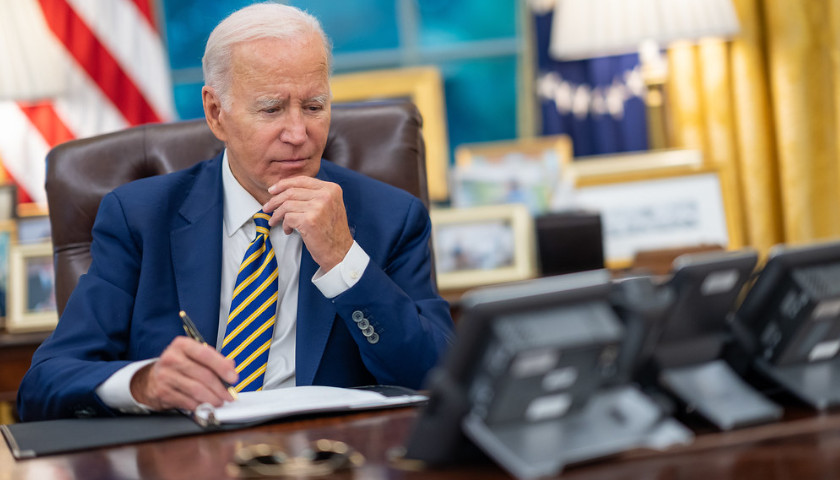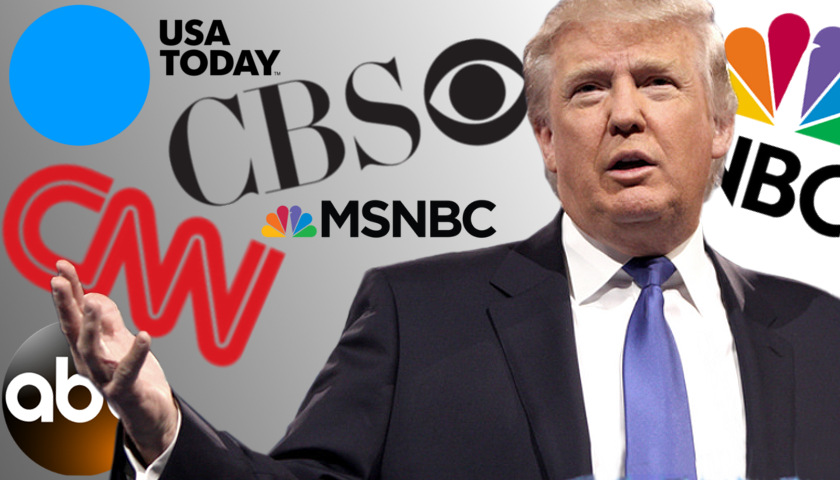by J.T. Young
Listen closely and you will hear Biden being scapegoated for Democrats’ policy failures. In 2020, Democrats had only one candidate who could beat Trump, and Biden had only one candidate whom he could beat. It was a match made in heaven. Now, three years in, that heavenly match is looking devilishly difficult, and doubting Democrats have only themselves to blame.
Hardly a day goes by without a story about Democrat angst over the president’s poor poll numbers. After winning in November 2020 with 51.3 percent of the popular vote, Biden rose further in the approval polls, reaching 55.7 percent on April 4, 2021, according to the RealClearPolitics national polling average. From there it has been an unmistakable plunge. On Oct. 18, RCP’s average of national polling had Biden at just a 40.8 percent approval rating (versus 55.1 disapproval).
Head-to-head match ups with Trump look better. RCP’s Oct. 17 average of national rematch polling has Biden trailing by a scant 0.8 percent (44.5 percent to 45.3 percent); however, these are deceptive. Biden needed a 4.4 percentage margin in 2020 to win 306 to 232 in the electoral college — just 36 electoral votes above the 270 needed to win, with many of those coming in extremely close state wins.
Democrats are rightly nervous but know there is little they can do. Sitting presidents win their party’s nomination. Even four years into the Great Depression, Republicans stayed with Hoover, and when Teddy Roosevelt challenged William Howard Taft in 1912, he lost. It would take Biden withdrawing (as Lyndon B. Johnson did in 1968) to get him off the Democrat ticket, and Biden, after two previous runs for the nomination and almost half a century in Washington, is not leaving.
Even if Democrats want to ignore history — both America’s presidential and Biden’s personal ones — there are things they cannot ignore.
Money is one. The last thing they need is to squander buckets of boodle on primary challenges to Biden when their nominee will almost certainly face Donald Trump, who will not have needed to use any appreciable resources to secure the Republican nomination. Forget campaign financing laws’ definitions about donations for primaries and the general election. The fact is that only so much Democrat money is out there, regardless of when and where you use it. Democrats do not need to be using it here.
Unity is another. A meaningful primary challenge will only be divisive and will threaten November unity. According to 2020 exit polling, 37 percent of respondents identified themselves as Democrats. With Biden’s overall approval at just over 40 percent, he is perilously close to having party-only support. Democrats need all theirs onboard in 2024.
Democrats also face the issue of paucity; there are no credible options on their bench. There were none in 2020 either, which is why they chose Biden. There are fewer now. Several are in Biden’s Cabinet, but consider how many have raised themselves by being there — Pete Buttigieg? Kamala Harris? And the ones outside his Cabinet — Elizabeth Warren, Cory Booker, Amy Klobuchar — have any raised their national standing?
However, the biggest reason is that Biden is not Democrats’ real problem. Their policies are. Biden has pursued them with vigor — especially those from the furthest left of the Democrat fringe. Those from that fringe will undoubtedly cite things they wanted and Biden has not pursued, but there are few things within the realm of political plausibility that he has not tried to gain for them.
Big spending and higher taxes? Check and check. And Biden wanted more. Only the refusal of any Republicans and two now former Democrats — Sens. Joe Manchin (W.Va.) and Kyrsten Sinema (Ariz.) — prevented more.
Stringent environmental laws and mandates? Biden has done all he can through regulation because opposition within his own party stopped him from doing more.
Student loan forgiveness? The Supreme Court stopped it. Nevertheless, to Joe, “no” means not “no” but “go.” So, despite what the Supreme Court says, Biden is still trying to do it.
This was the implicit deal struck in 2020: put Biden’s face on Democrats’ leftwing policies. Biden has upheld his end of the bargain — so much so that Sen. Bernie Sanders (Vt.-I), the greatest threat to his renomination, is not challenging him. Instead, this time Sanders is endorsing Biden. And why not? Biden has been the willing vessel for Sanders’ policies.
Biden is in 2023 where he was throughout the 2020 Democrat nomination cycle: not terribly popular with the base. It is easily forgotten that, according to RCP’s average of nomination polling, Biden stood at just 16.5 percent support on Feb. 18, 2020, and, after he effectively secured the nomination, he was at 60.8 percent when Sanders ended his campaign on April 8, 2020. According to Oct. 17 RCP polling, Biden’s support stands at 61.3 percent among Democrats today.
Biden is hardly blameless in his plight. His is no more than a weathervane White House, responding to political winds that only blow to the left.
So, Biden is stuck in reverse and Democrats are stuck with Biden. Whether Americans will stick with Biden is another thing. Sensing that they clearly may not, Democrats are beginning to offload their policy cargo from the S.S. Biden that is listing dangerously to the left. Above all else, they do not want their precious policy cargo to go down with him. Better to blame Biden now for their policies than accepting it if things go poorly next November.
– – –
J.T. Young was a professional staffer in the House and Senate from 1987–2000, served in the Department of Treasury and Office of Management and Budget from 2001–2004, and was director of government relations for a Fortune 20 company from 2004–2023.








